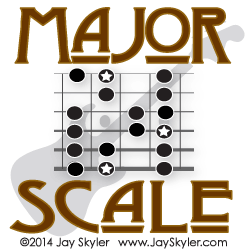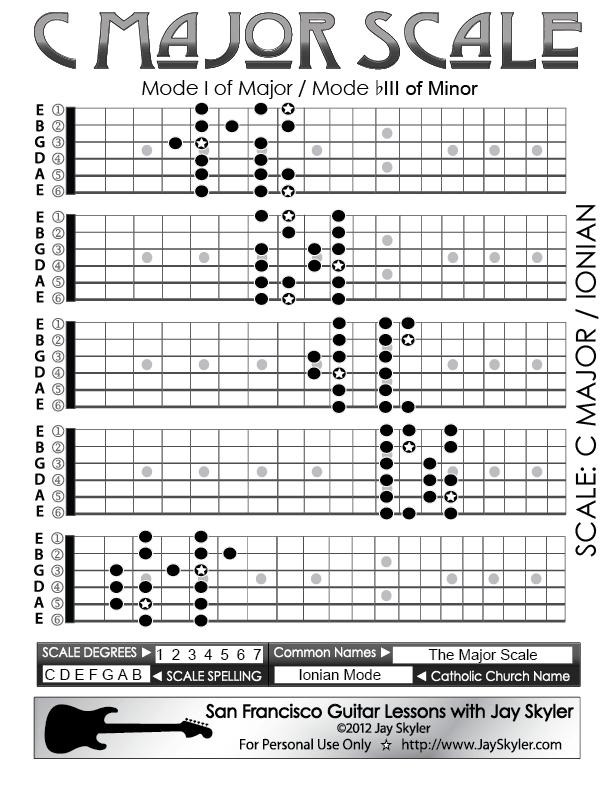Major Scale Guitar Fretboard Patterns- Chart, Key of C
by Jay SkylerGuitar Lesson Summary & Chart Explanation
C Major Scale
-
C Major Scale Notes:
- C D E F G A B
-
Major Scale- Scale Degrees:
- 1 2 3 4 5 6 7
-
Major Scale Alternative Names:
- Ionian
The Major Scale is a diatonic scale sometime called the The Ionian Mode. Ionian mode is the old name used for it by the Catholic Church. Many guitar sites and videos like to call it the Ionian mode because it sounds fancier and therefore they seem smarter (guitarists are a vain bunch, myself included). I prefer to call it the Major scale, but regardless you should know both names and know that they refer to the same thing. If you spend a few minutes memorizing the various names for things, you will never be intimidated by jargon.
It is the first mode of Major and the third mode of Minor (Built on the flatted third degree). See:
How Important is the Major Scale on Guitar?

The Major scale is the dominant scale in European Classical Music, consequently, we number notes in a scale (which we then call scale degrees), by convention, in terms of the major scale (Major gets the numbers: 1 2 3 4 5 6 7, no sharps or flats). But is this our "go-to" scale for playing a stadium, and will it sell even a single beer at the local rock 'n' roll dive bar? Probably not. Although of immense theoretical importance, riffs and solos in Rock, Blues, and Metal are not usually based on the Major scale. When you hear a Major sounding guitar solo, it's more commonly the Pentatonic Major Scale you are hearing.
If you are starting out on Rock, Blues, or Metal guitar, or are just starting to play lead guitar, you need to master the Blues Scale first. It is worth all of the other scales on this site put together. The C Major scale is probably the easiest scale to learn on piano and is the starting point of many piano methods, whose primary aim is to teach students to play European Classical Music, a genre where the Major Scale is the undisputed king.
Most guitarists, however, play popular music of varying degrees of heaviness. These genres have at their core the Blues Scale, which you should learn first. You should still learn the chords for Major keys (along with the chords for Minor keys)which are in the Chord and Arpeggio Diagram section of this website.
To summarize, you have to know the chords in Major and Minor keys, these are essential. But learning the CAGED system patterns of the Major scale and improvising leads with it is of minimal importance in the beginning (unless you play Jazz). You should probably learn the Pentatonic Major scale first. Fortunately, because of how modes work, by the time you need the full Major scale you will already know its patterns because it shares them with a few other scales that get used all the time (like Natural Minor and Dorian).
As mentioned earlier, although we infrequently use the Major Scale for riffs and guitar leads, scale degrees are numbered, by convention, with the Major Scale as a baseline. This is just fine, as we need to set something as the baseline, and this way we use the same numbering system as the other musical styles. But again, please avoid thinking of the Major scale as the Master scale for Rock, Blues, and Metal because in reality the Blues Scale is.
So here's how it works: Major is numbered 1 2 3 4 5 6 7, with no flats or sharps. When a degree in a scale is a half step lower (aka one fret down) than in the Major we say its flatted, when a half step higher (aka one fret up) we say its sharped. We then call the resulting degree the flat or sharp (insert the number name here).
Why is the Major Scale seldom used for guitar solos? One reason is it has 2 notes that are traditionally considered dissonant: the 4 and the 7. What the hell does that mean? It means that those two notes have a tendency to sound bad if you land on them at the wrong time (especially the 7th scale degree). Pentatonic Major avoids this issue by dropping those two notes. The other reason is that unless you really work it with good rhythm and phrasing, the Major scale can sound REALLY hokey, obvious, and lame (again the 7th scale degree is the big culprit). So avoid sounding like a cheeseball by mastering other scales first (especially Blues, Pentatonic Major, and Natural Minor), then when you start to use Major, you can force your own style and interpretation on it.
Remove the 7 and you have the Hexatonic Major Scale. See:
Take away the 4 and the 7 and you have the Pentatonic Major Scale See:
The Guitar Fretboard Diagrams show all 5 CAGED system forms of the Major Scale on the guitar neck in the key of C.

